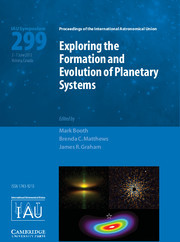Description
Exploring the Formation and Evolution of Planetary Systems (IAU S299)
Proceedings of the International Astronomical Union Symposia and Colloquia Series
Coordinators: Booth Mark, Matthews Brenda C., Graham James R.
This book reports on recent results in the formation and evolution of planetary systems.
Language: English
Subject for Exploring the Formation and Evolution of Planetary...:
Publication date: 01-2014
430 p. · 17.8x25.2 cm · Hardback
430 p. · 17.8x25.2 cm · Hardback
Description
/li>Contents
/li>
Recent years have seen a dramatic increase in our understanding of planetary systems. Initially, new exoplanets were discovered through the effects they have on their parent stars ? whether through radial velocity, transits or microlensing methods ? but now the technology and the techniques have been developed to image light from exoplanets directly. Vast improvements have also been made in our ability to resolve circumstellar matter from protoplanetary disks, through transition disks to debris disks. These dramatic new observations have led to new advances in our theoretical understanding of the formation and evolution of planetary systems. The proceedings of IAU Symposium 299 report on recent results of this field covering the range from the detailed imaging of protoplanetary disks to the modeling of planetary atmospheres. The volume benefits both active researchers and graduate students entering this dynamic and rapidly progressing field.
Preface; 1. High contrast AO imaging: latest results in direct exoplanet imaging; 2. Peering into circumstellar disks: transformative interferometry and high resolution imaging; 3. Building planets in protoplanetary disks: earliest evidence; 4. Co-evolution of disks and planetary systems; 5. Detailed studies of known exoplanets and exoplanet systems; 6. Debris disks as signposts of planetary systems; 7. Models of planetary formation and evolution; 8. Evolution of planetary systems.
© 2024 LAVOISIER S.A.S.
These books may interest you

Complex Planetary Systems (IAU S310) 114.03 €



